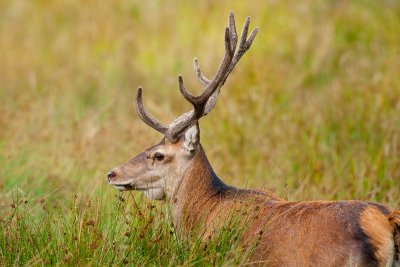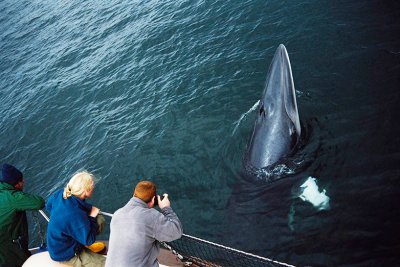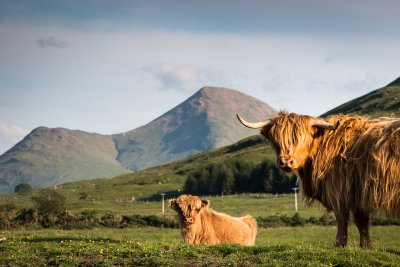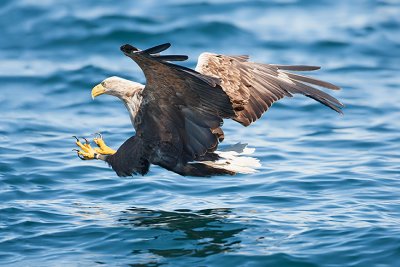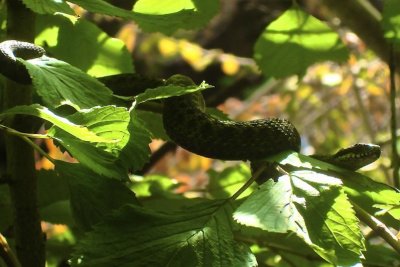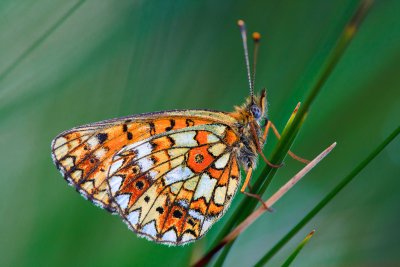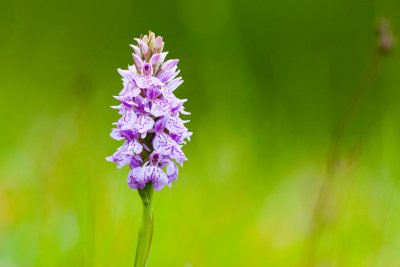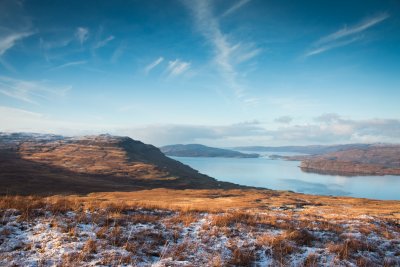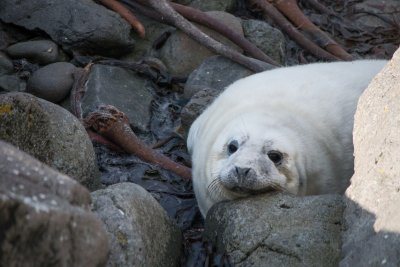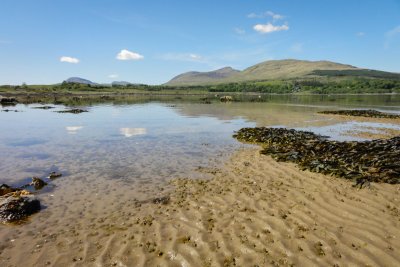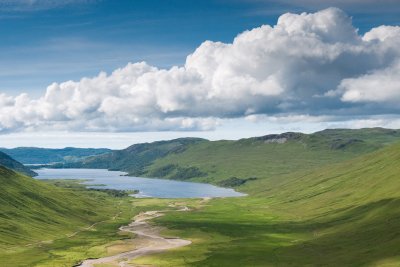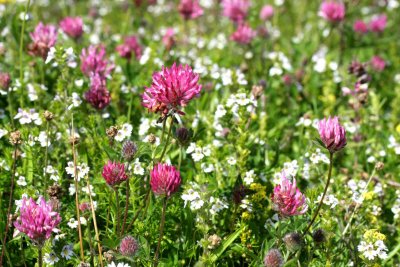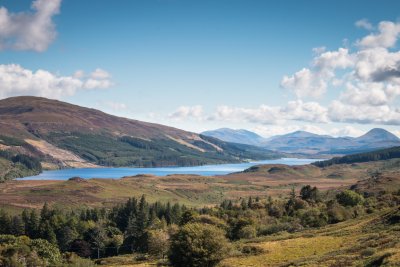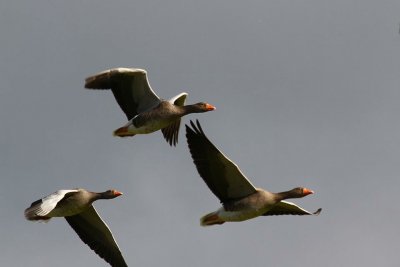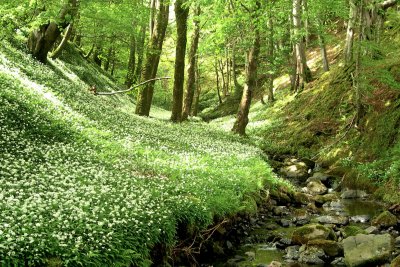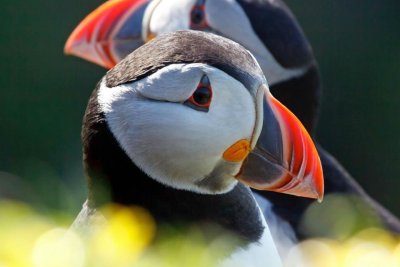Species
Mammals
The entire coastline of Mull is inhabited by otters and signs of their territorial markings (spraints) can be found on prominent features all around the shore. Most of these animals hunt mainly in the sea, frequently bringing their larger prey items to the shore enabling close-up views of these magical creatures. The females give birth to cubs at any time of year, and can sometimes be seen in family groups, playing together in the shallows or on offshore, weed-covered rocks.
Both harbour (common) and grey seals can be seen in locations around the shore, swimming in the sea or lounging on rocks. Watch out for them 'bottling': dozing in the water with their heads bobbing up and down above the surface like a floating bottle, or 'porpoising': arching out of the water just like a dolphin. Both species of seal give birth to pups locally, the harbour seals usually in June and the greys in October. Sometimes exotic creatures turn up, like the bearded seal from the Adriatic that remained for sometime around the shore of Loch na Keal.
Red deer are numerous and can be seen in locations throughout the island, although in summer many of them head up to the higher moorland to feed on the nutritious upland vegetation. In winter they are more often sighted around the coast when they move along the shoreline, feeding on the fresh seaweed that has been washed onto the beaches and rocks. Watch out for them crossing the roads at dusk and dawn in winter. The red deer rut reaches its peak in October when you hear the evocative roar of the stags echoing across the moorland. Organised trips to view the contesting males are usually arranged at this time.
Roe deer are absent from Mull, and the only other deer species found on the island are fallow, which form small herds in a few places, most notably in the woodland around Knock. Mountain hares occur in small numbers in many areas, their coats moulting for a third time to snow camouflage in winter. Some creatures do not change colour fully, however, and it is not unusual to see a mountain hare that is half ginger-brown and half white. They have suffered from a loss of heather (due to over-grazing by sheep and deer) that robs them of their natural cover and food. Rabbits occur in many places on the island, and have boom and bust years due to myxomatosis.
One of the most unusual and interesting creatures that occurs on Mull in several small herds (or tribes as they are more correctly called) is the impressively horned wild goat. There is much folkore attached to this animal and no-one is really certain how these creatures originally got to the island. They are important ecologically for helping to maintain flower-rich habitats along the more remote coasts such as that around Carsaig in the south of the island, where there are few other grazing/browsing animals.
Stoats and weasels occur in small numbers, while native polecats are rare: many individuals of this latter species show the characteristics of domesticated ferrets that have reverted to wild creatures. The non-native American mink are relatively common, especially along coasts, despite ongoing attempts to control their numbers. They cause significant damage to ground-nesting shorebirds and other species. Pine martens are not thought to have occurred on Mull until recently, when they appeared on the east coast of the island. No-one knows for sure how they arrived, but they are certainly increasing in numbers and spreading.
Moles were introduced to the island several hundred years ago, and hedgehogs occur, although currently not in sufficient numbers to be a problem to ground-nesting birds. Smaller mammals such as the short-tailed field vole can be abundant in some years and then form the staple diet of birds of prey such as buzzard, which have been known to fledge 5 young in the boom years.
Certain mammal species are absent from Mull such as the badger and both red and grey squirrels. Foxes and wild cats were formerly present, but were reputedly hunted to extinction over 200 years ago. Today, only escaped domestic cats can be seen as feral creatures, although some of the larger tabby individuals bear a striking resemblance to their truly wild cousins.
Other Large Marine Creatures
The seas around the island are home to harbour porpoises, and there is a resident pod of bottlenose dolphins. As the seawater warms in summer they are joined by a range of other cetaceans including common dolphin, minke whale, white-sided dolphin and orca. Basking sharks also appear regularly in large numbers at this time when their food, plankton, blooms.
Boat trips go out in search of these creatures in summer, but sightings can be had occasionally from ferries and from land, especially in the Sound of Mull and Tobermory Bay, and at Duart, Pennygown, Bloody Bay and Grasspoint.
Domestic Animals
Several farms on Mull, such as Ardalanish near Bunessan, keep the impressive and photogenic highland cattle, including some black individuals that are similar to the original kyloes once kept by crofters. A range of breeds of sheep are farmed on the island, mainly Scottish black-face and Cheviots, although there are also Hebridean, Herdwick, Shetland, Jacob and the unusual Zwartbles.
Birds
Mull is perhaps most noted for its strong populations of birds of prey, with large numbers of buzzard, hen harrier, short-eared owl, golden eagle and white-tailed eagle. The latter species has been a great reintroduction success story and Mull has the highest nesting density of these birds in Britain. They returned naturally to Mull and bred on the island from their release sites on Rhum and in Wester Ross. Other breeding birds of prey include sparrowhawk, kestrel, peregrine, tawny owl, barn owl, merlin and long-eared owl. Goshawk are also recorded and ospreys usually pass through on migration.
Most visible, however, is the wide range and high number of shorebirds that occur as residents, summer visitors, migrants or winter visitors. These include resident grey heron, oystercatcher, curlew, red-breasted merganser and redshank, which are joined by common sandpiper, ringed plover, turnstone, whimbrel and a host of other species at different times of year. Numerous other birds can also be seen foraging along the strand line, including hooded crows who often fly into the air with shellfish, dropping them onto the rocks in an attempt to break the open the shells. Shag and cormorant are common fishing in coastal waters and eider and shelduck can be seen in small numbers in sea lochs and along the western coast of Iona.
In spring the sand martins, house martins, swallows and other breeding summer visitors arrive bringing with them the warmer weather. Suddenly the moorland is alive with wheatears and the strange calls of cuckoos, which still return to Mull in good numbers. The display flights of snipe and woodcock over their territories are spectacular at this time, and you may be lucky to hear red-throated or black-throated divers calling as they fly over from their freshwater loch nesting sites to the fishing areas at sea. Dippers occupy territories along a few burns, while reed bunting and sedge warbler nest in waterside reedbeds and ring ouzels can be found in a few isolated wooded ravines.
In summer, sea birds occur around the Mull coastline in large numbers. Puffin, guillemot and razorbill are seen in huge rafts or fishing as individuals or small groups. Manx shearwater, common tern and arctic tern are regularly seen flying, while gannets often come close inshore to fish, especially in rough weather.
Iona is known for its nesting corncrakes and around 40 pairs usually breed there each year. It is also good for finches that feed on the seed-heads in the flower-rich meadows. The large trees next to the Heritage Centre are home to a rookery, and Iona is one of the only places on the islands that you find jackdaws. Mull also supports good numbers of breeding stonechat, linnet, twite and yellowhammer, while tree sparrows are also present in small numbers. Red grouse and ptarmigan can be found occasionally on upland heather, especially around Ben More.
In the largest and richest areas of semi-natural deciduous woodland, members of the tit family occur frequently along with treecreeper, great spotted woodpecker, tawny owl and species such as redstart, pied flycatcher and wood warbler. Goldcrest and common crossbill nest in the large areas of conifer plantation that occur on the island. Winter brings large numbers of visiting birds such as redwing, fieldfare and waxwing, along with flocks of whooper swan and geese such as Greenland white-fronted, barnacle and pale-bellied brent. Great northern divers and little grebe are common around the coast, and glaucous gulls are regular winter visitors.
Mull has its fair share of uncommon visitors with a chance of seeing species such as black stork, rose-coloured starling, hoopoe, chough and bittern. Interestingly, birds that are common in other parts of Britain such as magpie and nuthatch are absent or rare on Mull.
Amphibians and Reptiles
The freshwater habits of the island support strong populations of frogs, toads and palmate newts, these amphibians even spawning in brackish rock pools quite close to the shore. Adders occur in the drier areas of moorland and grassland, as do one of their main prey items, the common lizard. Slow worms can also be found, particularly around current and past human habitation, but grass snakes do not occur.
Invertebrates
Mull is home to a wide range of moths and butterflies, including some of the rarest species in Britain and Europe. Marsh fritillary, dark green fritillary, small pearl-bordered fritillary and grayling are just a few of the species that can be seen on the wing at various times throughout the summer. Spectacular moths such as emperor and narrow-bordered bee hawkmoth occur, and Mull and Ulva have small populations of the slender scotch burnet moth, a species that occurs nowhere else in the World. Occasionally there are large migrations of butterflies and moths to the island including peacock, painted lady, silver Y moth and even the amazing hummingbird hawk moth sometimes finds its way across the Sound of Mull.
Dragonflies also occur in profusion in summer with impressive creatures such as gold-ringed and common hawker hunting small insects over watercourses and along forest rides. The island also supports numerous examples of species from other invertebrate groups including bees, beetles, hoverflies and cave spiders.
Plants
The varied habitats and equitable climate support a diverse flora with well over 5,000 species and varieties recorded. Perhaps the most beautiful habitats are the shell-sand grasslands known as machair. At their peak the myriad flowerheads twinkle in the sun with a great diversity of species, most significantly grass of Parnassus, bugle, harebell, field gentian, lady's-mantle, wild carrot, fairy flax and frog orchid. Notable plants of other habitats include sea holly, wood bitter vetch, Scot's lovage, and numerous orchid species such as greater butterfly, northern marsh, heath spotted, twayblade, broad-leaved helleborine and bird's-nest.
There are few areas of ancient woodland on the island, but those that do exist are incredibly rich in plants and fungi. These stunted hazel and oak woodlands are collectively known as Celtic Rainforest, because of their dampness and clean air that sustains a rich diversity of mosses, liverworts and lichens. Scot's pine are present in some areas, but there do not appear to be any areas of true Caledonian pine forest. Uncommon trees and shrubs include aspen, juniper and common and Swedish whitebeam.
Woodland plants such as bluebell, wood anemone and wood sage form spectacular carpets of blooms not only in the woodland, but also in open grassland areas where trees have been cleared in the past. The combination of the white flowers of meadowsweet and the purple spikes of purple loosestrife create a heady mixture where they flower together along damp ditches, while Mull's 'national' plant, the yellow flag iris, blooms in profusion along the banks of watercourse in most years.
Habitats
Upland
The vegetation is largely dominated by sedges, mosses and lichens, with scattered plants of alpine ladies mantle, yellow saxifrage, mountain everlasting, roseroot, deer-grass and heathers: where the three species of heather remain in abundance, the moorland blooms in the late summer with the varied shades of purple and pink and the subtle green hues of the leaves. Curlew and a few other waders nest here, as do red-throated and black-throated divers around upland lochans. Ptarmigan are scarce, only usually being found on the upper slopes of Ben More, while snow bunting occur here, and along the coast, in winter.
Marine
The sea around Mull is noted for its diversity and abundance of fish, crustaceans and other marine life. The Sound of Mull is one of the proposed Marine Protection Areas in Scotland based mainly on its importance for common skate. There are resident harbour porpoise and bottlenose dolphins around Mull, and in summer other species of cetacean can be seen including common dolphin, white-sided dolphin, Risso's dolphin, minke whale and killer whale (orca) the latter species sometimes coming close in to shore after their prey when harbour seals are pupping. The warming waters of the Gulf Stream cause blooms of plankton in the summer and this attracts large numbers of basking sharks to the seas around Mull. Sometimes the dorsal fin and tail of these huge creatures can be seen moving backwards and forwards just offshore as these creatures glide along with their mouths open, filtering out the microscopic creatures which are their only food.
Harbour seals can regularly be seen swimming, bottling or porpoising in the main sea lochs or basking on offshore islets and rocks around the coast. Grey seals are usually found further out to sea, although the occasional individual can be seen closer in, such as the originally named 'Sammy' that sometimes hauls out on the Fionnphort jetty, especially when fishermen are landing their catch. Seabirds such as gannet, puffin, Manx shearwater, guillemot, razorbill, black guillemot and various species of gull, tern and skua can be seen from boats, or the shore, at different times of year and in different weather conditions.
Pollack, conger eel, skate, rays, cod, whiting, spur-dogs, plaice and sand eel are some of the sea fish that occur in good numbers most years, the health of population of the latter species being critical for the breeding success of the sea bird colonies, the biggest of which is on Lunga, one of the Treshnish Isles. The sea lochs of Scridain and Loch na Keal, and bays such as Calgary are particularly attractive to divers - black-throated, red-throated and great northern, and species of duck such as mallard, eider, wigeon and teal. Red-breasted merganser, shag and cormorant are present all year, while migrant swans and geese visit on migration.
More and more 'exotic' species turn up in Mull coastal waters. In the last few years there have been sightings of leatherback turtle, sperm whale and several species of fish more normally found in Mediterranean water (a possible indication of climate change and warming sea temperatures).
Coastline and Estuaries
The Isle of Mull has around 300 miles of coastline with a variety of habitats from flat shell-sand beaches to almost vertical rock cliffs. A variety of seaweeds occur, with channelled wrack at the top of the shore, bladder wrack lower down, and laminaria with their large flat fronds below. The tangles of stranded weed are a rich hunting ground for a wide range of bird species from waders to pipits, who are particularly in search of sand-hoppers. Rock pools are home to a dazzling array of marine species such as crabs, prawns, blenny, anemones, coral weed and a range of colourful algae. If you are lucky you will also find a tiny hermit crab scuttling around in its seashell home.
The exposed mud and silt found in the estuaries of the main rivers on Mull support a very rich invertebrate and mollusc fauna that especially attracts wading birds, gulls and ducks, including oystercatcher, curlew, redshank, greenshank, turnstone, ringed plover, mallard and shelduck. These and other areas on the island also regularly attract osprey on migration. The shallow waters of the advancing tide are also the favourite hunting zones of otters, and birds such as red-breasted merganser, great northern diver and grey heron. Aros is especially good for teal and wigeon in winter, while mute swans occur in small numbers all year round.
Fidden, near Fionnphort, and Inch Kenneth are area particularly known as a stop-over places for wintering flocks of geese, including white-fronted and barnacle, also whooper swans. The dunes and upper areas of sandy beaches form habitats for unusual plant species including sea holly, sea rocket, wild cabbage, prickly salt-wort and scurvy-grass. The many shades, from deep pink to almost white, of the flowerheads of thrift also line the shore, where the roots of this plant delve deep for moisture in the coastal rock crevices and ledges. Also watch out for the tiny tunnel entrances of sand bees that nest on the south-facing dune edges.
Beachcombing can be a rewarding pastime with a vast array of natural (and unnatural) items washed up. Goose barnacles, jellyfish, sea urchins, dog whelk egg cases and mermaids purses (dog fish egg sacks) can often be found, while all sorts of flotsam and jetsam is also turned up by the tide.
Freshwater
The freshwater lochs, burns and small pools are mostly nutrient-poor and acid and so do not support a very diverse or abundant invertebrate or fish fauna, although dragonflies are numerous and the lower stretches of watercourses, where they discharge into the sea, abound with wading birds and are the hunting grounds of otters. Fish that occur in these areas are salmon, trout, eel, stickleback and flounder.
Dippers breed in small numbers, having large territories along some of the watercourses that are richer in invertebrates. In winter, many of the freshwater lochs, such as those at Mishnish, Frisa, Ba and Pottie are visited by migrant and wintering waterfowl including whooper swans. Some lochs, such as that at Pottie near Fionnphort, have areas of abundant emergent vegetation. They are visited at different times of year by little grebe, tufted duck, golden eye, divers, geese and whooper swans and watch out for the occasional fishing otter. Freshwater habitats are particularly attractive to hunting bats on Mull, with species including Daubenton's, natterer's and both pipistrelles.
Machair
In summer the shell sand grassland known as machair is dotted with a myriad of beautiful wildflowers with species such as harebell, grass of Parnassus, yellow rattle, tormentil, ox-eye daisy, common knapweed, cat's-ear, field gentian and frog orchid. Two of the best places to see the spectacular show of machair flowers are at Ardalanish, near Bunessan, and Treshnish Farm, near Calgary. Look in the bare ground around rabbit burrows for more delicate plant species such as common stork bill and centaury. Sand martins nest in exposed sandy cliffs and banks along watercourses.
Lowland Moorland
Purple moor-grass is the dominant plant in most moorland areas, but bracken now forms large blocks in many of the drier areas. Left unmanaged, this plant forms dense stands with a decaying leaf litter that excludes most other plant species. Where grazing is not too intensive heathers, heath spotted orchid, northern marsh orchid, marsh lousewort, heath milkwort, tormentil, ladies bedstraw, bog asphodel, bog myrtle and cotton grass occur frequently. Another plant of the damp moorland/grassland habitats is the devil's-bit scabious, which has a beautiful purple flower and is significant as the foodplant of the rare marsh fritillary butterfly. Here too the carnation-scented flowers of the fragrant orchid attract moth pollinators at dusk. Sphagnum mosses are abundant in the wetter areas, and the insectivorous sundews and butterworts line the exposed peat along the margins of damp pools and runnels, especially where the red deer, cattle or sheep trample regular tracks.
The meadow pipit is the archetypal moorland bird, and forms the staple diet of hen harriers on Mull. It is also most parasitized by cuckoos. Wheatear, stonechat and skylark also occur in good numbers. Short-eared owl, merlin and kestrel also regularly hunt over this habitat. Mountain hares and red grouse are scarce in most places, only usually thriving where there is dense heather cover.
Farmland
Today, most of the farmland on Mull is used for grazing animals or silage and these lush green pastures attract large numbers of greylag geese and, in some places, the non-native Canada geese, which now breed on the island. The rough field margins attract flocks of finches such as goldfinch and linnet, while house sparrows and starlings still occur in small numbers around the farm buildings. Treshnish Farm in the north of the island won the RSPB farming and wildlife award recently and is a model of how farmland can be managed sympathetically for wildlife. It is one of the places in Mull where barn owl boxes have been erected, and pairs of these birds regularly raise young successfully. Rare plants, such as the wood bitter vetch and a host of orchids can be discovered here in the summer.
Woodland and Trees
Native deciduous woodland on Mull occurs in small areas of forest dominated by gnarled and twisted sessile oak and ash trees with an under-storey mainly comprising hazel, rowan, birch and willow. Special species like juniper and aspen occur in small pockets that grazing animals find inaccessible, especially in the steep, rocky places. The more extensive areas of mature deciduous forest provide nesting habitats for birds such as redstart, wood warbler and pied flycatcher, while the speckled wood butterfly is now quite numerous in the dappled shade of the woodland edges and clearings.
Sycamore and beech are non-native species that occur frequently, especially in the remnant parklands of planted trees surrounding the big estate houses such as at Aros Park near Tobermory. Large sycamores support a particularly rich epiphytic flora of mosses, lichens and ferns on their trunks and branches.
Large areas of coniferous plantations occur throughout the island. All of the trees are non-native species, apart from a small number of Scots pine, and are not usually good wildlife habitats therefore. A few invertebrate species, especially beetles with wood-boring larvae, do occur in large numbers, however, attracting insectivorous birds such as treecreeper and goldcrest Chaffinches, siskin, robin and wren occur frequently here too, and common crossbills nest in small numbers. White-tailed eagles are also fond of nesting in large coniferous trees, particularly mature Sitka spruce. The conifer forests also support large numbers of fungi in the autumn.
Offshore Islands
Ulva and Gometra are rich in many of the creatures and plants that make Mull so special, but Lunga, one of the Treshnish Isles, just to the north west of Staffa, hosts spectacular colonies of breeding seabirds in the summer, including numerous puffins, guillemots, razorbills, kittiwakes and fulmars. Corncrakes also nest there/

